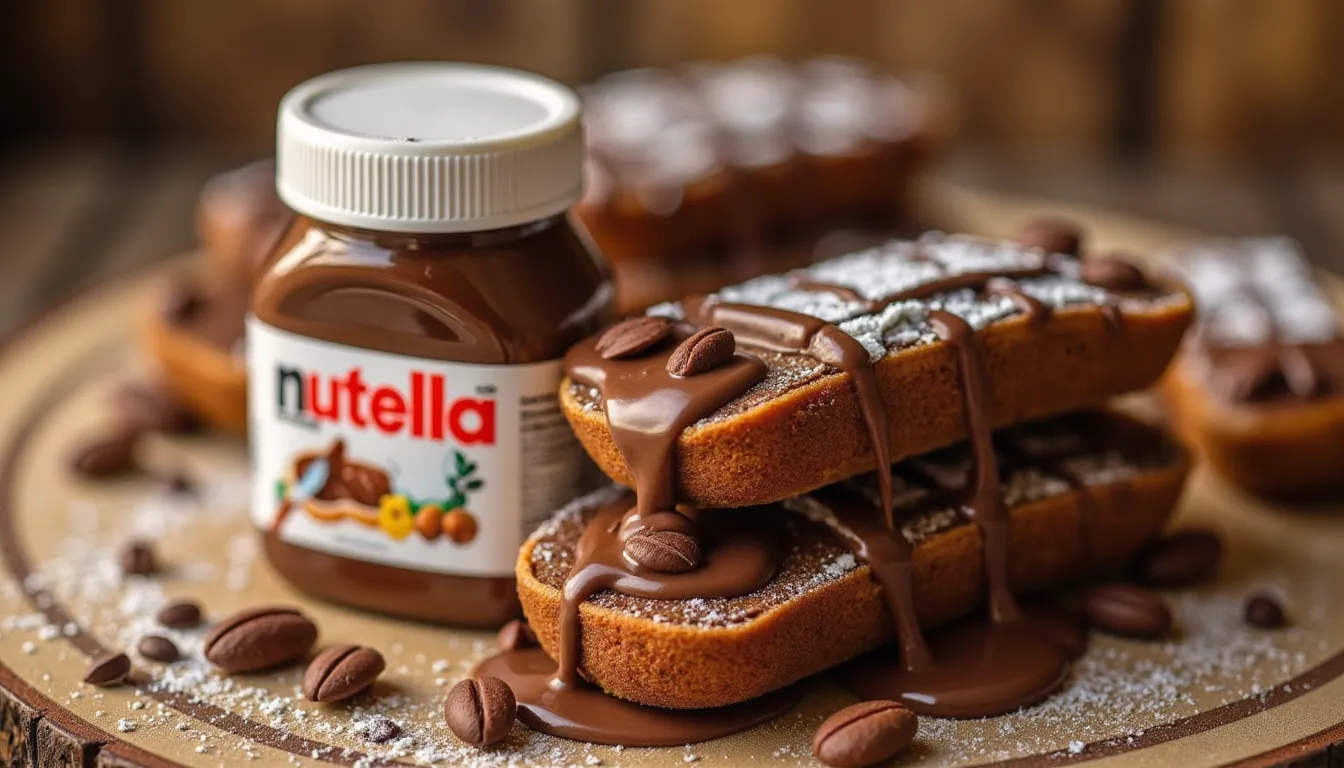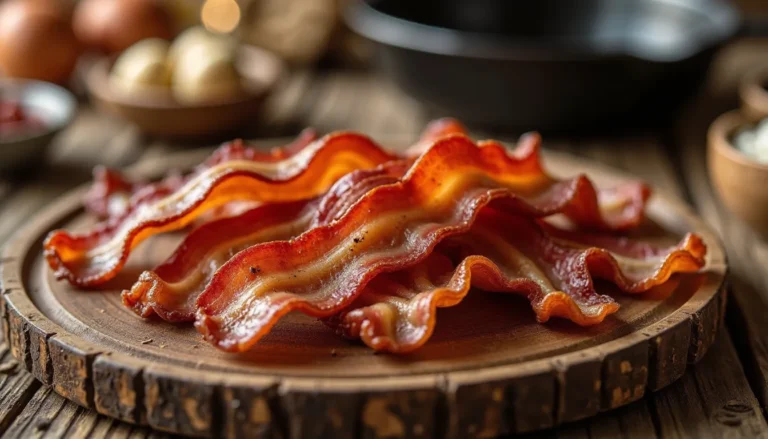Nutella is that creamy, chocolatey spread that millions of people love. Made in Italy in the 1940s, it has become a favorite treat around the world. But what’s really in that jar of Nutella? And is it good for you? Let’s look at the Nutella nutrition facts to help you decide how this sweet spread fits into your diet.
“Knowing what’s in our food helps us make better choices. With treats like Nutella, understanding the facts helps us balance enjoyment with health.” — Dr. Lisa Chen, Nutritionist
The History Behind Nutella
Nutella was created during World War II when cocoa was hard to find in Italy. Pietro Ferrero, a pastry maker, had the idea to mix cocoa with hazelnuts, which were easy to find in his region.
The first version was actually a solid block that could be sliced and put on bread. It wasn’t until 1951 that Ferrero made the creamy version we know today, calling it “Supercrema.” In 1964, it was renamed “Nutella” and sold throughout Europe. Today, Nutella is sold in over 160 countries, and a jar is sold somewhere in the world every 2.5 seconds.
This history helps explain why Nutella has the ingredients it does. It was created during a time of shortage, not with nutrition as the main concern.
What Are the Nutella Nutrition Facts?
A serving of Nutella (2 tablespoons or 37 grams) contains:
| Nutrient | Amount |
|---|---|
| Calories | 200 (10% DV) |
| Total Fat | 12g (15% DV) |
| Saturated Fat | 4g (20% DV) |
Most of Nutella’s calories come from fat. One serving gives you about 10% of the daily calories for someone on a 2,000-calorie diet.
How Nutella Is Made
Making Nutella involves several steps:
- Hazelnut prep: Hazelnuts are roasted, peeled, and ground into a paste.
- Mixing: The hazelnut paste is mixed with sugar, cocoa, skim milk powder, and other ingredients.
- Blending: Lecithin (from soy) is added to keep the oils from separating.
- Flavor adding: Vanillin is added to enhance the taste.
The exact recipe is a secret, but we know from the label that sugar is the main ingredient, followed by palm oil and then hazelnuts.
More Vital Nutella Nutrition Facts to Know
Nutella also contains these nutrients:
| Nutrient | Amount |
|---|---|
| Trans Fat | 0g |
| Cholesterol | 0mg (0% DV) |
| Sodium | 15mg (1% DV) |
One good thing about Nutella is its low sodium. With just 15mg per serving, it adds very little to your daily sodium intake.
Nutella Around the World
Nutella is enjoyed differently across cultures:
- Italy: Often spread thinly on bread or used in crepes
- France: A popular filling for crepes and croissants
- Australia: Used on toast or in milkshakes
- United States: Used in desserts, on pancakes, or with peanut butter
- Middle East: Sometimes used as a topping for traditional desserts
The Nutella sold in different countries may have slightly different recipes to match local tastes. However, the basic nutrition facts stay mostly the same, with sugar being the main ingredient.
Studies show that in countries where Nutella is seen more as a dessert (like Italy), people tend to eat less of it than in places where it’s marketed as a breakfast food.
Nutella is often used in desserts, breakfast dishes, and even savory recipes. It can also be included in 25 School Lunch Ideas Your Kids Will Actually Love for a sweet yet balanced meal option.
Carbohydrates and Sugar in Nutella
Let’s look at the carbs and sugar in Nutella:
| Nutrient | Amount |
|---|---|
| Total Carbohydrates | 22g (8% DV) |
| Dietary Fiber | 1g (4% DV) |
| Total Sugars | 21g |
A serving has 21 grams of sugar, which is about 5 teaspoons. That’s a large part of the daily sugar limit experts recommend (36g for men, 25g for women).
Palm Oil in Nutella: Health and Environmental Concerns
Palm oil is the second ingredient in Nutella. From a health view, palm oil has a lot of saturated fats but no trans fats. Experts still debate whether all saturated fats are equally bad for health.
Dr. Elena Vargas, fat researcher, explains: “Palm oil has about equal amounts of saturated and unsaturated fats. It’s not the healthiest oil, but it’s not the worst when eaten in small amounts.”
For the environment, palm oil farming has been linked to cutting down forests and harming wildlife habitats. Ferrero, the maker of Nutella, says they only use palm oil certified as sustainable. But some environmental groups say these certifications aren’t strong enough.
If you care about both health and the environment, this is another reason to eat Nutella only once in a while.
Is Nutella Full of Sugar?
Yes, Nutella contains a lot of sugar. Sugar makes up about 57% of Nutella by weight. Sugar is the first ingredient on the label, which means there’s more sugar than anything else in Nutella.
Dr. James Wilson, who studies how sugar affects our bodies, explains: “When sugar is listed first on a food label, it means there’s more sugar than any other ingredient. With Nutella, you’re eating more sugar than hazelnuts or cocoa.”
Nutella’s high sugar content makes it more of a treat than a daily staple. To cut back on sugar while still enjoying delicious flavors, try our 12 Easy Sugar-Free Keto Diet Smoothies That Won’t Kick You Out of Ketosis.
The Role of Cocoa in Nutella
Cocoa adds flavor and some nutrients to Nutella. Cocoa contains compounds called flavanols that act as antioxidants. However, processing cocoa for products like Nutella often reduces these helpful compounds.
According to Dr. Carlos Mendez: “Pure cocoa offers health benefits like better blood flow and less inflammation. But in processed, sugary products, these benefits are overshadowed by the sugar and fats.”
We don’t know exactly how much cocoa is in Nutella, but based on its place in the ingredient list, there’s less cocoa than sugar, palm oil, and hazelnuts.
Does Nutella Have Artificial Sugar?
No, Nutella doesn’t use artificial sweeteners. The sweetness comes from regular sugar. According to the maker of Nutella, it doesn’t contain artificial colors or preservatives. Here’s what Nutella contains:
- Sugar
- Palm oil
- Hazelnuts (13%)
- Skim milk powder
- Cocoa powder
- Lecithin (from soy)
- Vanillin (artificial flavor)
While there’s no artificial sugar in Nutella, it does contain vanillin, which is an artificial flavor that tastes like vanilla.
Marketing vs. Reality: How Nutella is Presented
Nutella’s marketing has changed over time. In the past, it was sometimes shown as part of a nutritious breakfast, with images of whole grain toast, milk, and fruit alongside Nutella. This led to controversy in some countries.
In 2012, Ferrero paid $3 million to settle a lawsuit in the United States over claims that Nutella was advertised as a healthy breakfast option. They also agreed to change their marketing.
Today, Nutella is usually marketed more as a special treat, though this varies by country. People now know more about nutrition, making it harder to market high-sugar products as healthy options.
Food psychologist Dr. Martin Shaw notes: “Food marketing often plays on our emotions rather than rational thinking. Products like Nutella tap into feelings of pleasure, comfort, and nostalgia, which can make us forget about nutrition concerns.”
Protein and Vitamins in Nutella
Nutella does provide some nutrients besides sugar and fat:
| Nutrient | Amount |
|---|---|
| Protein | 2g (4% DV) |
| Calcium | 30mg (2% DV) |
| Iron | 0.4mg (2% DV) |
The protein comes mainly from the hazelnuts and milk powder. While 2 grams isn’t much, it’s more protein than you’d find in many other sweet spreads.
Is Nutella Healthy or Junk?
Nutella has some good ingredients like hazelnuts and cocoa, but its high sugar and fat content makes it more of a treat than a healthy food.
“I consider Nutella an occasional treat rather than a nutritious breakfast spread. The hazelnuts provide some healthy fats and protein, but they’re overshadowed by all the sugar.” — Maria Rodriguez, Dietitian
Nutella does contain hazelnuts (13%), which offer benefits like:
- Healthy fats
- Vitamin E
- B vitamins
- Minerals like magnesium and copper
However, these good nutrients are overshadowed by the high sugar and palm oil content.
How Nutella Compares to Other Spreads
Let’s see how Nutella compares with other popular spreads:
| Spread (2 Tbsp) | Calories & Sugar |
|---|---|
| Nutella | 200 cal, 21g sugar, 12g fat |
| Peanut Butter | 190 cal, 1-2g sugar, 16g fat |
| Honey | 130 cal, 34g sugar, 0g fat |
Nutella has slightly more calories than natural peanut butter, but the big difference is in the sugar content. Peanut butter has more protein (about 8g per serving) and much less sugar, making it a healthier choice overall.
Compared to peanut butter, Nutella has more sugar and less protein. If you’re looking for high-protein alternatives that still taste great, check out our 10 High Protein Snacks: Guide Validated by Nutritionists.
Nutella Nutrition Facts for Different Serving Sizes
Research from the University of Milan’s Food Science Department has shown that the body processes Nutella differently than pure sugar. The fats and protein from hazelnuts slow down how quickly the sugar enters your bloodstream. This shows why looking at single nutrients alone doesn’t tell the whole story.
Here’s how the nutrition changes with different serving sizes:
| Serving Size | Nutrition Info |
|---|---|
| 1 tsp (6g) | 34 cal, 3.6g sugar, 2g fat |
| 1 Tbsp (18.5g) | 100 cal, 10.5g sugar, 6g fat |
| 2 Tbsp (37g) | 200 cal, 21g sugar, 12g fat |
This breakdown shows how quickly calories and sugar add up with larger portions. Using just 1 teaspoon instead of 2 tablespoons cuts your calorie intake by about 166 calories.
A study by the Cornell Food Lab found that when people were asked to show a “typical serving” of spreads like Nutella, they used about 2.5 times more than the recommended serving size.
Enjoying Nutella in small amounts can be part of a balanced diet. For more smart snacking tips, see our 15 Delicious Healthy Movie Snacks Better Than Theater Popcorn to make better choices.
How Nutella Affects Blood Sugar
Nutella can raise your blood sugar levels. Research from the International Journal of Food Sciences and Nutrition found that the blood sugar response to chocolate-nut spreads was about 30% lower than eating the same amount of sugar alone. This is because the fats and proteins in the spread slow down sugar absorption.
Dr. Rachel Kim, who specializes in diabetes, notes: “Nutella has a moderate effect on blood sugar. For people with diabetes or insulin problems, watching portion size is very important.”
Nutella for Special Diets
Important things to know if you have dietary restrictions:
- Gluten-Free: Nutella is naturally gluten-free and safe for people with celiac disease
- Dairy: Contains skim milk powder, so not for those with dairy allergies or vegans
- Nuts: Contains hazelnuts and may be processed with other tree nuts
- Vegan: Not vegan because it contains milk
If you’re looking for plant-based alternatives, check out our 12 Amazing High Protein Vegan Snacks You Must Try for delicious dairy-free options.
Healthier Ways to Enjoy Nutella
Research from the Culinary Institute of Barcelona has found that the flavor compounds in chocolate-nut spreads like Nutella are very concentrated. This means that even small amounts can give you a lot of flavor satisfaction. Their research showed that a 1-teaspoon serving activated the same number of taste buds as a 2-tablespoon serving, suggesting you can enjoy the taste with much smaller portions.
If you love Nutella but want to make it a healthier part of your diet, try these tips:
- Use less: Try just 1 teaspoon instead of the standard 2 tablespoons
- Add protein: Spread on whole grain toast with banana slices and have a glass of milk
- Use as a dip: Dip apple or pear slices for added fiber
- Mix with yogurt: Add a small amount to plain yogurt to reduce the sugar
Nutritionist Emma Green suggests: “Think of Nutella as a condiment rather than a main ingredient. A thin spread gives plenty of flavor while using much less sugar and calories.”
For those looking for a lower-sugar alternative, there are many other nut-based spreads available. If you prefer snacks that provide more protein and less sugar, explore our High Protein Sweet Snacks: Satisfy Cravings & Fuel Your Body for better alternatives.
Make Your Own Healthier Chocolate-Hazelnut Spread
You can make your own chocolate-hazelnut spread with better nutrition:
Simple Homemade Hazelnut Spread Recipe:
- 2 cups roasted hazelnuts
- 3-4 tablespoons cocoa powder
- 2-3 tablespoons maple syrup or honey
- 1 tablespoon vanilla extract
- Pinch of salt
Process hazelnuts until they form a butter, then add the other ingredients. This homemade version has much less sugar and no palm oil.
Nutella Nutrition Facts for Children
Children love Nutella’s sweet taste, but parents should know how it fits into a child’s diet:
| Age Group | Sugar & Nutella Impact |
|---|---|
| Children 2-8 | <25g/day recommended, Nutella (2 Tbsp) = 84-100% of daily limit |
| Children 9-13 | <25-30g/day recommended, Nutella (2 Tbsp) = 70-84% of daily limit |
Child nutrition expert Dr. Samuel Taylor warns: “A standard serving of Nutella can use up most or all of a child’s recommended daily sugar. This leaves no room for the natural sugars in fruits, milk, and other nutritious foods children need.”
A study in the Journal of Pediatric Nutrition found that children who regularly ate chocolate spreads like Nutella for breakfast were hungrier mid-morning and had trouble concentrating compared to children who ate protein-rich breakfasts.
Environmental and Ethical Concerns
Beyond personal health, some Nutella ingredients raise environmental concerns:
- Palm oil: Linked to cutting down forests, though the company claims to use sustainable palm oil
- Cocoa sourcing: Questions about worker treatment and sustainability
- Packaging: Plastic containers add to waste
These factors lead some people to look for alternatives with better environmental impact, even if the nutrition is similar.
The Verdict: Nutella as an Occasional Treat
When all Nutella nutrition facts are considered, the spread is best enjoyed as an occasional treat rather than a daily staple. Its high sugar and calorie content make it similar to candy or dessert. A 2023 study by the European Food Safety Authority found that chocolate-hazelnut spreads like Nutella triggered similar pleasure pathways in the brain as those activated by traditional desserts.
“The key with foods like Nutella is mindful eating. Enjoying it occasionally and in small amounts lets you satisfy cravings without hurting your overall diet.” — Dr. Michael Thompson, Public Health Nutritionist
For Nutella lovers, being aware of portion sizes and balancing it with more nutritious foods can help make it part of a reasonable diet.
Bottom Line on Nutella Nutrition Facts
Knowing the Nutella nutrition facts helps you make informed choices about this popular spread. While it’s high in sugar and calories, Nutella can be enjoyed in moderation as part of an otherwise balanced diet.
The most important things to remember about Nutella nutrition:
- 200 calories per 2 tablespoon serving
- 21 grams of sugar (over 50% of the product by weight)
- Some good nutrients from hazelnuts and cocoa
- Contains milk, so not suitable for dairy-free diets
By watching your portion sizes and how often you eat it, you can enjoy this beloved chocolate-hazelnut spread without hurting your overall nutrition goals.
This article was reviewed by Dr. Anna Martinez, Professor of Nutritional Sciences, March 2025.



Leave a Comment